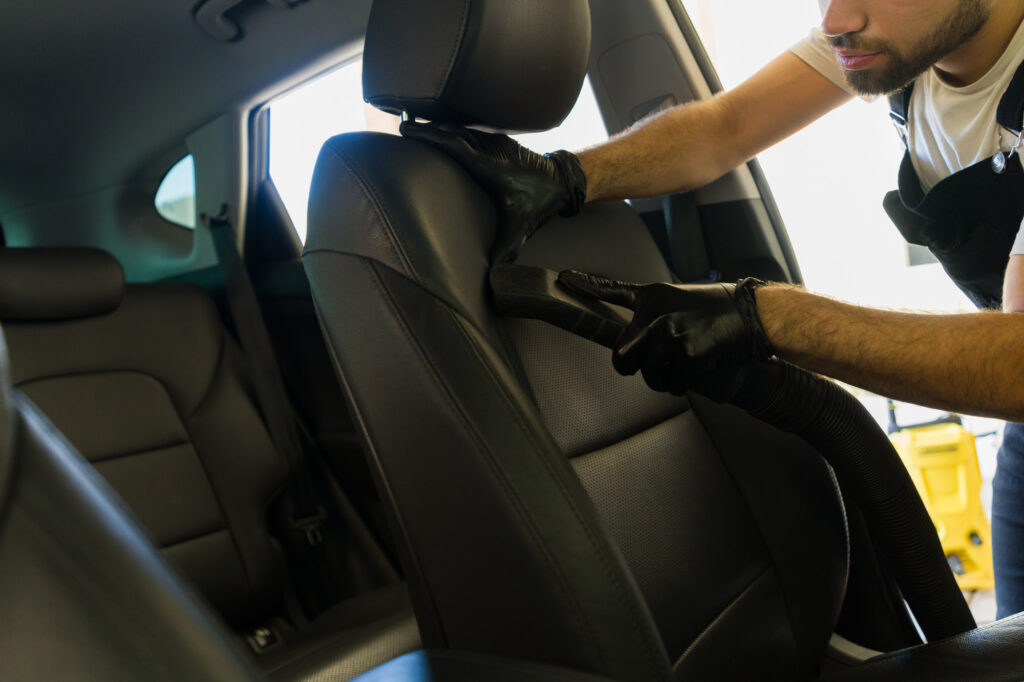It’s frustrating when your ride’s gorgeous leather seats crack, rip, and tear. Fortunately, it’s not the end of the world. Depending on the damage, they might be repairable.
While it’s easier to hire a professional for the repairs, you can deal with the damage yourself. You’ll need to get your hands on some tools and leather repair products, but you can save a lot of money in the long run by cutting labor costs out of expenses entirely.
If you’re keen on learning how to repair tears in leather car seats, read on.
How to Repair Leather Car Seats: Simple Methods
There are three ways to repair leather car seats: use a leather repair kit, install leather patches to hide the damage, or apply fluid leather and conditioner.
There’s no best method when it comes to patching up leather, so choose what’s most accessible to you.
Use Leather Repair Kits
Leather repair kits include tools and solutions that can patch up holes, cracks, and scratches in anything made of leather. Find one that matches your seat’s leather.
Before starting, make sure the seat is clean by scrubbing off dirt, residue, and other debris with soap and a rag. Using a leather repair kit usually involves the following steps.
- Slide a small sheet of backed cloth behind the tear.
- Apply leather adhesive to stick the cloth onto the leather.
- Apply leather filler onto the backed cloth until there’s one unified layer that matches with the rest of the seat.
- Cover the leather filler with colorant until it matches the color of the leather seat.
- Apply leather sealant to prevent the colorant from fading or rubbing off.
- Allow the leather sealant to dry before using the seat again.

Install Leather Patches
Another way to patch up tears and holes in leather car seats is to use patches. These patches add another layer to the car seat, hiding the hole and reinforcing it with wax paper.
Some drivers use patches large enough to cover the hole, but this leaves a clear indicator of where there used to be a tear. If you’d prefer your leather seats to look more seamless, you can apply leather patches over a much larger area.
Once you’ve found a leather patch that matches your car seat’s leather, follow these steps:
- Trim the leather patch so it completely covers the leather seat.
- Slide a sheet of wax paper behind the tear or hole.
- Apply leather adhesive to the edges of the leather patch.
- Place the leather patch over the tear so that it covers the seat and the wax paper.
- Allow the adhesive to dry before using the seat again.
Apply Fluid Leather
Last but not least, you can use fluid leather to refinish tears, cracks, and scratches without needing to apply patches or backed cloth of any kind.
Simply find fluid leather that matches your leather seat’s color and some leather conditioner to prevent the fluid from drying itself out. Make sure the leather is clean before following these steps:
- Dilute some fluid leather with a small concentration of water at a 70:30 ratio.
- Apply the fluid leather diluted with water with a sponge over your leather seat.
- Make sure to rub over cracks, scratches, and dry patches.
- Apply a final coating of undiluted fluid leather over the seat to cover cracks and make the application look more seamless.
- Apply conditioner to your leather seat after the fluid leather has dried.
- Allow the conditioner to dry before using the seat again.
Tips for Taking Care of Your Leather Seats

While it pays to know how to repair tears in leather seats, it’s definitely better to take measures to protect them from damage in the first place. Here are some tips to help you keep your seats in great condition.
Keep Sharp Objects Covered
Keys, knives, and other sharp items can dig into your leather upholstery even when they’re in your pockets. So don’t keep such objects in your back pockets when you drive. Place them in your front pockets or your glove compartment instead.
If a sharp object is pushed into a leather set with enough force or weight, it can puncture the leather. Scrapes and scratches are difficult enough to deal with as is, but a hole in leather will require patchwork to fix – and even then, it’ll never look the same.
Minimize Exposure to Sunlight and Heat
Sunlight dries leather, causing it to break apart and crack, so park in shaded areas as much as possible. Find ways to limit sunlight exposure to your leather seats.
You can also cover your vehicle with a tarp when it’s not in use or drive with a sunshade on your windshield.
Regulating your vehicle’s temperature is just as important because extreme heat can damage leather seats. If your A/C is off, drive with the windows open to prevent or minimize heat buildup in your ride.
Avoid Eating or Drinking Inside Your Car
Food and drinks can ruin leather seats, leaving sticky residue and stubborn stains. This doesn’t necessarily mean that you can’t bring any food or drinks with you inside the car.
It just means you should make it a habit to avoid drinking and eating when driving. Urge your passengers to do the same. Cover drinks with lids and keep food in sealed containers.
If anything spills on your leather seat, make sure to wipe it clean immediately to prevent stains. Besides leaving unsightly marks, stains on leather can wear away the material.
Vacuum Leather Seats Regularly
It’s a good practice to vacuum your leather seats to suck up dirt, crumbs, and other debris that might be too hard to clean by hand.
Dirt and loose bits of food tend to harden over time, and if they aren’t removed immediately, they could scrape against the leather. The longer dirt is left uncleaned, the more likely it can damage your leather seats.
In some cases, the dirt could become impossible to remove after sinking in too deep.
Use Leather Cleaners
Don’t forget to wipe the leather down with cleaning solutions after vacuuming it to get rid of all the stains and dirt.
Use a leather cleaner and a soft towel. Generally, you should avoid using rough towels when working with leather because you might accidentally scratch it.
Bear in mind that you should only use cleaning solutions designed for leather. Some chemicals found in general cleaning solutions could damage leather.
Apply Leather Conditioners After Cleaning
Once you’ve finished cleaning your leather seats with a leather cleaner or a vacuum cleaner, your next step should always be to apply some leather conditioner. The conditioner stops leather from losing moisture, preventing it from cracking and drying itself out.
Dry leather scratches and breaks apart easily, so the conditioner makes it last a lot longer. Condition leather once every two to three months to keep it in great shape.
Any information provided on this Website is for informational purposes only and is not intended to replace consultation with a professional mechanic. The accuracy and timeliness of the information may change from the time of publication.


























